Among the mouth-breathingest of mouth-breathing Republicans, it’s a well-known fact that every November or so, we libruls gather in our covens and plot the paganization of Christmas. In theirLeft Behind-style fantasies, we are the legions of Satan, come upon the Earth to foist secular ideas and Godless traditions upon the flock of the Lamb. They claim that only the Bible stands in defense of the faithful against the pernicious attacks of the heathen First Amendment, and that we will not be satisfied until we have, Egyptian-like, eradicated every trace of monotheism from our once-God-fearing civilization. Each year, the scarred veterans of the (self-)Right(eous) stir their zealots to action, and in public squares and mangers throughout the land, battles over the soul of American culture are waged.
As in all wars, sometimes an enemy’s gallantry on the field of battle impresses even a bitter foe – Napoleon, remarking on the Russian cavalry then crashing into his lines, said “Now these are Kossacks!” – and it’s in this spirit that Brandon Friedman suggested we take a moment to cite the valor of our opposition. Others (links below) have done a great job “honoring” individual wingnut actions – now join me, if you will, in the Cave of the Moonbat, where we’ll take a look at what, exactly, they’re fighting for.
Historiorant: From all over the left blogosphere, the commendations of our gallant foe are pouring in; verily, he is formidable, but the very fact that the good guys are compelled to note in their dispatches the adversary’s heroic action under fire (clammyc @ DocuDharma) and the times his bravery was such that he won the day (Erick Schmeltzer @ Huffington Post) speaks to the fact that the pro-tannenbaum forces are fighting tenaciously for every inch. Rather like the Confederates at Pickett’s Charge, they may be trying to storm a solid position in the name of a dubious set of causes, but we have to respect the temerity it takes to throw oneself into the breach for an issue one really doesn’t understand.
“…for you know neither the day nor the hour in which the Son of Man is coming.” — Matthew 25:13
Nor when He first arrived, either, it would seem. Dates are always problematic for our friends on the far right, their occasional efforts to tweak the calendar to their will notwithstanding. From determining the date of the birth of Christ to the day of His return, evangelical math has run into problem after problem. This really isn’t too surprising, given the cubit-based system of measurement, the firm belief that some Biblical figures lived over 900 years, and their odd interpretation of galactic time as revealed to them by an Irish Anglican bishop 350 years ago. Why don’t we celebrate October 23rd – Creation Day, according to Bishop Ussher – anyway?
The obsession with Jesus’ birth – which, in terms of the re-envisioned “traditional” Christian theology championed by Global War on Christmas (GWoC) uber-kommandant Bill O’Reilly, is at least as important as His death and resurrection – is something about which modern Christians are far more likely to get up in arms about than their forebears. As we’ll see in a moment, the occasion of Christ’s birth was used by early missionaries as a means of making pagan pre-converts comfortable with the new faith – nowhere in the New Testament is found a command to venerate the Virgin Birth. If one looks into the older, pick-n’-choose sections of the Bible, quite the opposite is true.
Was the Son of God born on December 25th? The short answer is “most likely not,” given that few facts point to that date as any more likely than the standard 1 in 365 chance – and several of the known ones surrounding 12/25 actually make it an unlikelier time than a date in the spring. For one thing, it seems unlikely that the ruler of a far-flung, multi-latituded empire would initiate a travel frenzy in the middle of the winter…
And it came to pass in those days, that there went out a decree from Caesar Augustus that all the world should be taxed. And this taxing was first made when Cyrenius was governor of Syria. And all went to be taxed, every one into his own city.
…but probably more important to the fixing of December 25 at Jesus’ birthday was the usurpation of the god-figure who’d earlier laid claim to that particular calendrical moment. As it turns out, the popularity of holy births on or about the time of the Winter Solstice is something that far predates monotheism itself, to say nothing of the Jesus-come-lately Son of God.
Wouldn’t you know it? Those officious Romans are involved…
Jesus, of course, lived his entire life as a Jew under Roman rule (well, Mitt might have a slightly different take on that), his homeland occupied and governed by foreigners and puppet kings. Nevertheless, none of the four canonized gospels – “the Constitution,” according to the Focus on the Family gang – mentions Jesus’ birth as being portentous of Jewish revolt. In other words, He is not portrayed as a sword-wielding dispenser of Holy Justice (all misinterpretations of Isaiah 9:6 aside) nor as the revealer of some new autocratic/utopian form of government based around the worship of He and His Father; that would come later, around the time of the Crusades. Hence, any effort to link the birth of Christ to some sort of foundational link to American government is sheer lunacy, despite the best efforts of some very determined historical revisionists. This simple fact likely comes as a real shock to this bonehead, who seems to think that he’s got us libs pegged dead to rights:
The privatizers of faith are the same social engineers who demand universal public health care, who embrace public welfare, who bid a nation to come learn their simple doctrine of the solitary value of tolerance. That is, except tolerance for Christians.
…and we would’ve gotten away with it, too, if it weren’t for you meddling theocrats.
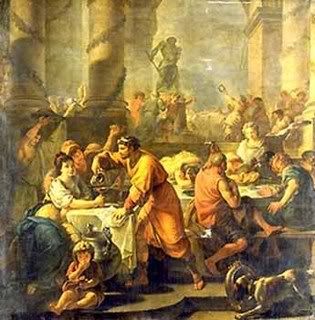 So if we can dispense with the notion of Jesus as a great government-overthrower-and-reorganizer, we can move on to the issue of religion in Rome, and back to the issue of December 25. This is no coincidence: Rome was generally a good place to be in December, owing to the large number of religious feasts and festivals in the latter part of the month. Taken together, the whole thing was called Saturnalia; though it varied in length depending on the era and emperor, it generally lasted around a week, beginning on December 17. It sounds like a party worth crossing the street for:
So if we can dispense with the notion of Jesus as a great government-overthrower-and-reorganizer, we can move on to the issue of religion in Rome, and back to the issue of December 25. This is no coincidence: Rome was generally a good place to be in December, owing to the large number of religious feasts and festivals in the latter part of the month. Taken together, the whole thing was called Saturnalia; though it varied in length depending on the era and emperor, it generally lasted around a week, beginning on December 17. It sounds like a party worth crossing the street for:
During the holiday, restrictions were relaxed and the social order inverted. Gambling was allowed in public. Slaves were permitted to use dice and did not have to work. Instead of the toga, less formal dinner clothes (synthesis) were permitted, as was the pileus, a felt cap normally worn by the manumitted slave that symbolized the freedom of the season. Within the family, a Lord of Misrule was chosen. Slaves were treated as equals, allowed to wear their masters’ clothing, and be waited on at meal time in remembrance of an earlier golden age thought to have been ushered in by the god. In the Saturnalia, Lucian relates that “During My week the serious is barred; no business allowed. Drinking, noise and games and dice, appointing of kings and feasting of slaves, singing naked, clapping of frenzied hands, an occasional ducking of corked faces in icy water-such are the functions over which I preside.”
Though it might sound more like a springtime Fat Tuesday, Saturnalia was about the winter solstice, for it was on that day – December 25, by the reorganized Julian Calendar – that the Sun itself was born. This dovetailed nicely with the ascendancy of the god Mithra, a deity imported from Iran by legionaries and immensely popular among Rome’s soldiers. Controversy rages as to how much of an influence Mithraism had on early Christianity; positions in the debate range from one extreme:
According to Persian traditions, the god Mithras was actually incarnated into the human form of the Saviour expected by Zarathustra. Mithras was born of Anahita, an immaculate virgin mother once worshipped as a fertility goddess before the hierarchical reformation. Anahita was said to have conceived the Saviour from the seed of Zarathustra preserved in the waters of Lake Hamun in the Persian province of Sistan. Mithra’s ascension to heaven was said to have occurred in 208 B.C., 64 years after his birth. This birth took place in a cave or grotto, where shepherds attended him and regaled him with gifts, at the winter solstice.
…to the other:
Back in the Roman era, Mithraism was perhaps Christianity’s leading competitor for the hearts and minds of others. Today Mithraism is religiously a non-factor, but it still “competes” with Christianity, in another way: It is a leading candidate for the “pagan copycat” thesis crowd as a supposed source for Christianity.
Irrespective of the degree to which Christianity and Mithraism influenced one another is the fact that Roman religion was pretty crowded by the fourth and fifth centuries CE. The empire itself was a patchwork of ethnicities, races, and ideas, tied together by culture-diffusing roads and trade routes in such a plethora of diversity that any modern dyed-in-the-wool conservative who came in contact with it would screaming for the hills; the empire’s decentralized, multi-pantheon approach to religious tolerance would similarly stupefy those who think that government has a patriarchal role in choosing the religious faith of its citizens. It seems that during this time, both Jesus and Mithra became imbued with aspects of sun-godhood (including the regular day of worship being established on the Day of the Sun each week), with Mithra gaining the upper hand as the focus of Saturnalia increasingly became the worship of Sol Invictus, the Invincible Sun.
Historiorant: Last week, we here in the Cave of the Moonbat saw that Akhenaton, the “heretic pharaoh,” had beaten the Romans to monotheistic sun-worship by like, 1500 years.
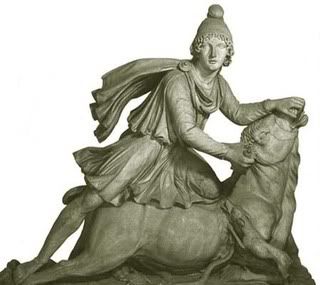 Many gods and goddesses competed for the hearts and minds of the people, up to and including the emperor himself, and though the Caesars’ dealings with religion always had a political slant to them, it wasn’t until relatively late in the Imperial Period – during the reign of Constantine I (306-337), specifically – that one of them went the route of converting the entire population to the worship of one god (plenty of them had established the primacy of one deity or another among the pantheons, but as we silly church/state separators note, that’s different from obligating the citizenry to trash their own beliefs in favor of the king’s sole preference). By 353 CE, the nascent Christian Church proclaimed that Christ had been born on the same day as Mithra (and the Egyptian Osiris, Greek Apollo and Bacchus, and the Chaldean Adonis…). Interestingly, the Eastern Church, which didn’t have the Mithra problem of Rome proper, did not move its designated celebration from January 6 – a/k/a (in the Western Church) the Feast of the Epiphany – the date (the 12th day after Christmas) of the arrival of the Three Wise Men.
Many gods and goddesses competed for the hearts and minds of the people, up to and including the emperor himself, and though the Caesars’ dealings with religion always had a political slant to them, it wasn’t until relatively late in the Imperial Period – during the reign of Constantine I (306-337), specifically – that one of them went the route of converting the entire population to the worship of one god (plenty of them had established the primacy of one deity or another among the pantheons, but as we silly church/state separators note, that’s different from obligating the citizenry to trash their own beliefs in favor of the king’s sole preference). By 353 CE, the nascent Christian Church proclaimed that Christ had been born on the same day as Mithra (and the Egyptian Osiris, Greek Apollo and Bacchus, and the Chaldean Adonis…). Interestingly, the Eastern Church, which didn’t have the Mithra problem of Rome proper, did not move its designated celebration from January 6 – a/k/a (in the Western Church) the Feast of the Epiphany – the date (the 12th day after Christmas) of the arrival of the Three Wise Men.
Re-Gifting a Holy Day
Ask most GWoC warriors about how the whole exchange-of-gifts thing got started, and they’ll tell you (if they’ve ever considered the matter at all) that it began with the Three Magi. (While we’re on the subject: since Caspar, Melchior and Balthasar were likely Median or Parthian Mithradatic or Zoroastrian priests, our conservative amigos would be probably be distressed to note that Iranian influence upon the Christian faithful goes back that at least that far, to say nothing of the Persian deity’s apparent muddying of the Christian nativity story). Even given all this time to get it right, however, Malkin and her ilk still miss the whole point of the Magi story – the gifts the Wise Men brought were offerings to the Christ-child, not to one another. I mean, it’s not like they stood humbly before the Lord and exchanged gifts among themselves in His exalted presence; if they had, certainly Matthew 2:10-11 would read a little differently:
When they saw the star, they rejoiced with exceeding great joy. And when they were come into the house, they saw the young child with Mary his mother, and fell down, and worshipped him: and when they had opened their treasures, they presented unto him gifts; gold, and frankincense and myrrh.
Emphasis mine – or am I wrong, and the whole gift-exchange more of a namaste-type “I honor the Jesus within you” thing? If so, I can certainly see why the GWoCers would risk cultural upheaval on behalf of crass commercialism…I guess – u.m.
Your resident historiorantologist would be remiss if he didn’t also note that of the four gospels, only half mention Jesus’ birth, and the two of them tell very different stories. Nevertheless, by the time of the Apostle Paul, it was considered okay to give directly to the Church – even encouraged. Here’s post-gospel Paul hitting up the Christians of Corinth in language a modern televangelist would recognize (and employ) in a heartbeat:
But just as you excel in everything-in faith, in speech, in knowledge, in complete earnestness and in your love for us-see that you also excel in this grace of giving. I am not commanding you, but I want to test the sincerity of your love by comparing it with the earnestness of others. For you know the grace of our Lord Jesus Christ, that though he was rich, yet for your sakes he became poor, so that you through his poverty might become rich.
And here is my advice about what is best for you in this matter: Last year you were the first not only to give but also to have the desire to do so. Now finish the work, so that your eager willingness to do it may be matched by your completion of it, according to your means.
When unable to reconcile their dual instincts favoring both “traditional” Christmas and “free-market” economics, conservatives usually retreat to the trenches of mysticism, wherein they wage a brutal mind-to-mind defense of the intentions or focus of the gifters and giftees, usually covering their atrocities against logic with a thick smokescreen made up of convoluted James 1:17: Every good gift and every perfect gift is from above, and cometh down from the Father of lights, with whom is no variableness, neither shadow of turning.
O Heidnischerbaum, O Heidnischerbaum!
In point of fact, the gift-giving is likely another remnant of Saturnalia, when people would often exchange presents – especially wax candles, to celebrate the rebirth of the Sun – amongst their family gatherings and neighborly revelries, but really, what good are such trinkets if one doesn’t have an 8-foot coniferous tree inside one’s house to put them under? The Bible is quite clear on how that tradition’s roots connect with the birth of Jesus:
Oh, wait; no, it’s not. While the custom might make sense if the nativity story had Mary giving birth beneath a pine tree, the Bible mentions nary a sacred shrub in conjunction with Jesus’ first hours. For the origins of this one, too, we must look far back – past the Romans, who decorated fir trees with red berries during Saturnalia; back, past the Babylonians, who told a god-related rebirth fable centered around an evergreen sprouting from a stump; at least all the way back to pre-Captivity Biblical times, during which the Prophet Jeremiah speaks pretty unambiguously about what God thinks of being worshipped with pagan trees:
Hear ye the word which the LORD speaketh unto you, O house of Israel: Thus saith the LORD, Learn not the way of the heathen, and be not dismayed at the signs of heaven; for the heathen are dismayed at them. For the customs of the people are vain: for one cutteth a tree out of the forest, the work of the hands of the workman, with the axe. They deck it with silver and with gold; they fasten it with nails and with hammers, that it move not.
It has taken the United States around 200 years to forget George Washington’s warning about entangling foreign alliances, about 50 to space on Ike’s premonition about the military-industrial complex, and only 7 to convince itself that human rights are stupid – so imagine the kinds of warnings that could be relegated to the dustbin of history over a 1500-year period! As usual with violations of their own clearly-stated edicts – q.v. the very sordid story of the Rev. Ted Haggard – those spreading the Good News had ample justification for not adhering to their own rules, and as usual, it was found to be that service to the faith demanded a relaxation of its own standards. Think of it as burning the Scriptures in order to spread them.
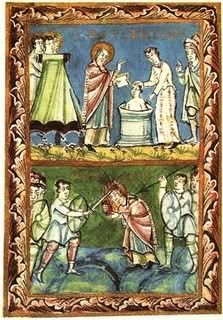 So it was that in during the 8th century, a Benedictine monk from Devon, England, set out for Frisia and Germany, so as to convert the Frankish pagans to the Way of the Cross. His given name was Winfrid, but Pope Gregory II renamed him Boniface; the moniker was later (i.e., posthumously) prefixed the moniker with the coveted “St.” (and the less-coveted title of “martyr”), and Boniface is now the patron saint of brewers, the Netherlands, and Germany, among other things. He had cajones of brass, that’s for sure; perhaps his example is why so many of the less-than-ummm…-confident men of the conservative camp are inspired to get so wound up about being able to publicly decorate a tree.
So it was that in during the 8th century, a Benedictine monk from Devon, England, set out for Frisia and Germany, so as to convert the Frankish pagans to the Way of the Cross. His given name was Winfrid, but Pope Gregory II renamed him Boniface; the moniker was later (i.e., posthumously) prefixed the moniker with the coveted “St.” (and the less-coveted title of “martyr”), and Boniface is now the patron saint of brewers, the Netherlands, and Germany, among other things. He had cajones of brass, that’s for sure; perhaps his example is why so many of the less-than-ummm…-confident men of the conservative camp are inspired to get so wound up about being able to publicly decorate a tree.
Clearcutting in the Name of God
Bill O’Reilly likely imagines himself a kind of latter-day St. Boniface, but given the fact that he was too fearful of dying for a government-determined cause too risk enlistment in his country’s armed services during a time of war (his own bio page is hilariously evasive on this), it’s pretty unlikely that Boniface would ever see O’Reilly as anything more than a blowhard chump. In instituting the Christmas tree among the Odin-worshipping Franks, Boniface strode into a sacred grove of oak trees surrounded by Viking-type characters who each knew a thousand ways to kill a man with an ax, and challenged the god Thor to strike him down if Boniface were to harm the ancient Oak of Donar. Next…
Taking his courage in his hands (for a great crowd of pagans stood by watching and bitterly cursing in their hearts the enemy of the gods), he cut the first notch. But when he had made a superficial cut, suddenly the oak’s vast bulk, shaken by a mighty blast of wind from above, crashed to the ground, shivering its topmost branches into fragments in its fall. As if by the express will of God (for the brethren present had done nothing to cause it) the oak burst asunder into four parts, each part having a trunk of equal length. At the sight of this extraordinary spectacle, the heathens who had been cursing ceased to revile and began, on the contrary, to believe and bless the Lord.
The story goes that Boniface next indicated a fir sapling growing from the roots of the ancient oak was to be the new arboreal symbol of their faith, possibly indicating the Trinity through the sapling’s shape. According to www.saintboniface.info, he also told the new Christians:
“This humble tree’s wood is used to build your homes: let Christ be at the centre of your households. Its leaves remain evergreen in the darkest days: let Christ be your constant light. Its boughs reach out to embrace and its top points to heaven: let Christ be your Comfort and Guide”
The Christmas tree was apparently especially popular in Eastern Europe – this source has them being hung upside down from ceilings by the 12th century as a symbol of Christianity, which raises an interesting red-meat question for the Republican dogs to sink their teeth into: if an inverted cross is the height of blasphemy, than what of an inverted Christmas tree, which actually forms the shape of a cross when hung upside-down? Furthermore, what if such a practice were, in fact, a tradition that precedes most of your own by several centuries?
Christmas in the Age of Splinter Groups
It’s hard to know exactly when the first decorated Christmas trees appeared, but it was probably during or shortly before the 16th century – reports as to the exact date vary from 1510 in Riga, Latvia, to 1570 in Bremen, Germany, with several possible points and times in between. It was primarily a Protestant phenomenon (Martin Luther himself may or may not have had a Christmas tree), and mostly focused in northern Germany. From there, the practice spread over the next two centuries, down the Rhine and across Bavaria, eventually corrupting the Catholics of Austria (and thus Spain, via the Hapsburgs) and Eastern Europe.
That isn’t to say that Protestants were uniform in their regard for Christmas – the more stringent sects in Switzerland and Scotland came out foursquare against it. In what might be the real opening salvos of the War on Christmas, the holiday was banned in Scotland in 1583, and when ultra-religious nutjobs assumed tyrannical rule over England in the mid-1600s, it was banned there, too. By then, of course, religious separatists were already establishing a foothold on the east coast of America, and they took legal steps to ensure that they weren’t bringing any Old World pagan cooties with them:
“For preventing disorders, arising in several places within this jurisdiction by reason of some still observing such festivals as were superstitiously kept in other communities, to the great dishonor of God and offense of others: it is therefore ordered by this court and the authority thereof that whosoever shall be found observing any such day as Christmas or the like, either by forbearing of labor, feasting, or any other way, upon any such account as aforesaid, every such person so offending shall pay for every such offence five shilling as a fine to the county.”
From the records of the General Court, Massachusetts Bay Colony, May 11, 1659; via A Puritan’s Mind
Historiorant: Troutfishing‘s excellent diary a couple of weeks ago cited the same Mass. Bay Court records – and it also touches upon some topics – like Christmas sex in Japan – that your resident historiorantologist just isn’t going to be able to get to tonight.
Though the royal family, with its German connections, brought Christmas trees with them to England in the 1700s, and though Germany itself had developed Christmas marketing to a high form – they were stretching silver into tinsel by the centennial of Martin Luther’s letting of the indulgence cat out of the papal bag, and many towns were holding special midwinter markets on their picturesque walkplatzs (I’m especially partial to the one in Trier) – it wasn’t until the mid-1800s that Christmas caught on in England and France.
And what’s a conspiracy without the Queen of England being involved?
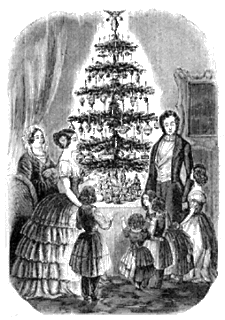 We’re accustomed to leaders so morally radioactive that we don’t often think of people copying the styles or goings-on popular in the land’s halls of power. This wasn’t always the case: When Queen Victoria and Prince Albert set up a Christmas tree and published a photo of themselves with it in 1846, English socialites fell all over themselves trying to ape the royal couple, followed quickly by inferiority-complex-suffering Americans, who aped the English socialites. By the 1850s, manufacturers had sprung up to provide crap to hang on the branches of the trees, though in a peculiarly American trait, people put national flags at the top. Methinks BillO would like to see this particular marriage of jingoism and religion return, but that he’d be conflicted about taking down the angel or star that’s currently there.
We’re accustomed to leaders so morally radioactive that we don’t often think of people copying the styles or goings-on popular in the land’s halls of power. This wasn’t always the case: When Queen Victoria and Prince Albert set up a Christmas tree and published a photo of themselves with it in 1846, English socialites fell all over themselves trying to ape the royal couple, followed quickly by inferiority-complex-suffering Americans, who aped the English socialites. By the 1850s, manufacturers had sprung up to provide crap to hang on the branches of the trees, though in a peculiarly American trait, people put national flags at the top. Methinks BillO would like to see this particular marriage of jingoism and religion return, but that he’d be conflicted about taking down the angel or star that’s currently there.
Victoria reigned over a period that saw amazing advances in the production of stuff, and a concurrent interest in new ways of selling more stuff. It turns out that paganism was rife with symbols ready and waiting to be exploited by the cunning entrepreneur, and during the late 1800s, such men saw to it that the modern rites of semi-secularized Christmas were firmly ensconced in our culture. The first printed Christmas card appeared in London in 1843 (of 1000 printed, 12 still exist in private collections – see an image of one here), and though they became quite the rage in Germany and England, it took another quarter-century for them to catch on in the United States.
The modern perception of Santa Claus – are there really elves in Christian theology? – also took root during this time, and though the story is often told that it was Coca-Cola that made him a part of our “traditional” Christmas, it appears that this may be an urban legend. There’s no doubt that Depression-Era Coke artist Haddon Sundblom helped to cement the popular image, but Santa as a bewhiskered, red-suit-with-white-fur-trim-wearing, jolly old elf was firmly a part of American culture by the 1920s, if not earlier.
 I’d love to historiorant on the origins of Santa, but this is already really long, and stories about Turkish saints and Dutch faeries would make it way longer still – perhaps next year. All’s I can say for now is: thank God someone is out there, making sure that the 80-year-ancient tradition of Santa remains sacrosanct in the modern Christian Christmas rites.
I’d love to historiorant on the origins of Santa, but this is already really long, and stories about Turkish saints and Dutch faeries would make it way longer still – perhaps next year. All’s I can say for now is: thank God someone is out there, making sure that the 80-year-ancient tradition of Santa remains sacrosanct in the modern Christian Christmas rites.
Historiorant: Why They Fight
The GWoC heroes are big believers in Goebbels Law: Repeat a lie often enough, and it will become established fact, regardless of the real truth. They live their lives by this maxim; their careers depend upon it, but since this angle on the debate is pretty viciously personal, I’ll go ahead and let one of their own make the argument from BillO’s own right flank:
The very foundation of the Christmas holiday is a lie. The Messiah was not born December 25th. He did not ask us to celebrate his birthday. He did not say to set up a tree in our house and decorate it and our houses with anything. Santa Claus does not exist. He doesn’t have reindeer that fly and he isn’t going to come on December 25th and leave any gifts. Everything is a lie. Is Yahweh the originator of this holiday? Or is it the father of lies? Yahushua condemned the leaders of that generation for teaching lies:
John 8:44 Ye are of your father the devil, and the lusts of your father ye will do. He was a murderer from the beginning, and abode not in the truth, because there is no truth in him. When he speaketh a lie, he speaketh of his own: for he is a liar, and the father of it.
So what – exactly – is it that conservatives are conserving, again?
In the GWoC, our foe gets bent way out of shape when he thinks that pagans are trying to remove from the holiday the symbols that Christians adopted from the pagans long ago – see this article from WorldNutDaily if you don’t believe me. The irony here is that in seeking to remove government-sponsored religious iconography, progressives are actually aiding the errant soldiers of the opposing side in finding their own path back to the Light – yet our efforts consistently go unrewarded by what should be an admiring opposition.
We certainly admire them – it takes nerve to stick by one’s beliefs when one doesn’t really know the reasons why one has them. Among the most surprising things about the GWoC is that conservative combativeness extends even beyond our place in space and time – in fact, their actions in defense of Christmas defy the expressed will of God Himself. Think of it: using the Lord’s name to justify rituals of which He would never approve – that takes balls!
And yet, too often we find our respect unreciprocated, and find ourselves left with nothing but our own, probably deeper, understanding of the real meaning of Christmas. Many of us see it as yes, a Christian holiday, and the recognized date upon which to celebrate Jesus’ birthday, but a lot of us also see it as an amalgamation of diversity – a joyous secular testament to what happens when societies interact and start swapping cultural elements. Yes, it has its origins in Roman sun-worship, but no, I do not pray to Sol Invictus – for me, the pagan threads in the Christmas quilt simply represent a continuity with the timeless, historic past that always lies just beneath the surface of our hyper-modern, high-speed society. I understand that I’m probably violating the proscriptions of Jeremiah myself – I am, after all, eager (in an academic sense) to learn of the ways of the heathen – but if that’s the case, I’m in good company: No less than the valorous generals of the Global War on Christmas proclaim their undying desire to actually practice and defend those very ways.
 So let’s hear it for our noble foe: He doesn’t have a clue what he’s fighting for, but he’ll assert to the death his right to fight over it!
So let’s hear it for our noble foe: He doesn’t have a clue what he’s fighting for, but he’ll assert to the death his right to fight over it!
Oh, and Merry (from the word’s medieval connotation of “blessed”) Christmas, Happy Holidays, and a Here’s Hoping for a great New Year, from the Cave of the Moonbat. May the season’s meanings, and not its definitions, fill your heart. ?
Historically hip entrances to the Cave of the Moonbat can be found at Daily Kos, Never In Our Names, Bits of News, Progressive Historians, and DocuDharma.

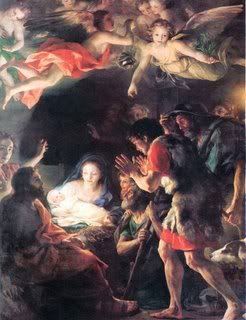

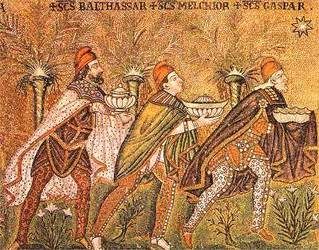

6 comments
Skip to comment form
Author
that Christmas has a great many pagan roots, so while I may be beating a dead horse here, at least it’s gathered up for your convenience a few of the things that Pat Robertson doesn’t want you to know about December 25th!
Sincerest of Holiday Greetings per your faith, from the Cave of the Moonbat!
w00t!
Sorry. I had to get that off my chest… again.
Merry Christmas, everyone else!
human need to have festivals of light and renewal in the solstice. I like all the mythology of the various cults, as they are tied to nature symbolically. The Christians main contribution of Peace on earth, Goodwill to men, and the celebration of the concept of love is ironic given the war zone they have created . War and the birth of Christ, the prince of peace, don’t seem very compatible. Thanks Moonbat and Happy Any Festival of Light in winter you.